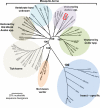Zika virus: History, emergence, biology, and prospects for control
- PMID: 26996139
- PMCID: PMC4851879
- DOI: 10.1016/j.antiviral.2016.03.010
Zika virus: History, emergence, biology, and prospects for control
Abstract
Zika virus (ZIKV), a previously obscure flavivirus closely related to dengue, West Nile, Japanese encephalitis and yellow fever viruses, has emerged explosively since 2007 to cause a series of epidemics in Micronesia, the South Pacific, and most recently the Americas. After its putative evolution in sub-Saharan Africa, ZIKV spread in the distant past to Asia and has probably emerged on multiple occasions into urban transmission cycles involving Aedes (Stegomyia) spp. mosquitoes and human amplification hosts, accompanied by a relatively mild dengue-like illness. The unprecedented numbers of people infected during recent outbreaks in the South Pacific and the Americas may have resulted in enough ZIKV infections to notice relatively rare congenital microcephaly and Guillain-Barré syndromes. Another hypothesis is that phenotypic changes in Asian lineage ZIKV strains led to these disease outcomes. Here, we review potential strategies to control the ongoing outbreak through vector-centric approaches as well as the prospects for the development of vaccines and therapeutics.
Copyright © 2016 Elsevier B.V. All rights reserved.
Figures




Similar articles
-
Zika virus outside Africa.Emerg Infect Dis. 2009 Sep;15(9):1347-50. doi: 10.3201/eid1509.090442. Emerg Infect Dis. 2009. PMID: 19788800 Free PMC article. Review.
-
The Zika outbreak of the 21st century.J Autoimmun. 2016 Apr;68:1-13. doi: 10.1016/j.jaut.2016.02.006. Epub 2016 Feb 28. J Autoimmun. 2016. PMID: 26925496 Free PMC article.
-
Zika virus: An emerging flavivirus.J Microbiol. 2017 Mar;55(3):204-219. doi: 10.1007/s12275-017-7063-6. Epub 2017 Feb 28. J Microbiol. 2017. PMID: 28243937 Review.
-
Zika virus: an emerging challenge to public health worldwide.Can J Microbiol. 2020 Feb;66(2):87-98. doi: 10.1139/cjm-2019-0331. Epub 2019 Nov 4. Can J Microbiol. 2020. PMID: 31682478 Review.
-
Zika Virus: New Clinical Syndromes and Its Emergence in the Western Hemisphere.J Virol. 2016 Apr 29;90(10):4864-4875. doi: 10.1128/JVI.00252-16. Print 2016 May 15. J Virol. 2016. PMID: 26962217 Free PMC article. Review.
Cited by
-
Discriminating arboviral species.J Gen Virol. 2021 Apr;102(4):001572. doi: 10.1099/jgv.0.001572. J Gen Virol. 2021. PMID: 33830905 Free PMC article.
-
Contrasted transmission efficiency of Zika virus strains by mosquito species Aedes aegypti, Aedes albopictus and Culex quinquefasciatus from Reunion Island.Parasit Vectors. 2020 Aug 6;13(1):398. doi: 10.1186/s13071-020-04267-z. Parasit Vectors. 2020. PMID: 32762767 Free PMC article.
-
Vector Competence of Aedes aegypti, Aedes albopictus and Culex quinquefasciatus from Brazil and New Caledonia for Three Zika Virus Lineages.Pathogens. 2020 Jul 16;9(7):575. doi: 10.3390/pathogens9070575. Pathogens. 2020. PMID: 32708536 Free PMC article.
-
Nervous System Manifestations of Arboviral Infections.Curr Trop Med Rep. 2022;9(4):107-118. doi: 10.1007/s40475-022-00262-9. Epub 2022 Sep 15. Curr Trop Med Rep. 2022. PMID: 36124288 Free PMC article. Review.
-
Highlights from the 2016 International Symposium on HIV & Emerging Infectious Diseases (ISHEID): 25-27 May, Marseille, France.J Virus Erad. 2016 Jul 1;2(3):187-92. doi: 10.1016/S2055-6640(20)30464-7. J Virus Erad. 2016. PMID: 27482461 Free PMC article.
References
-
- Akoua-Koffi C, Diarrassouba S, Benie VB, Ngbichi JM, Bozoua T, Bosson A, Akran V, Carnevale P, Ehouman A. [Investigation surrounding a fatal case of yellow fever in Cote d'Ivoire in 1999]. Bull Soc Pathol Exot. 2001;94:227–230. - PubMed
-
- Bearcroft WG. Zika virus infection experimentally induced in a human volunteer. Trans R Soc Trop Med Hyg. 1956;50:442–448. - PubMed
Publication types
MeSH terms
Grants and funding
LinkOut - more resources
Full Text Sources
Other Literature Sources
Medical
Miscellaneous

